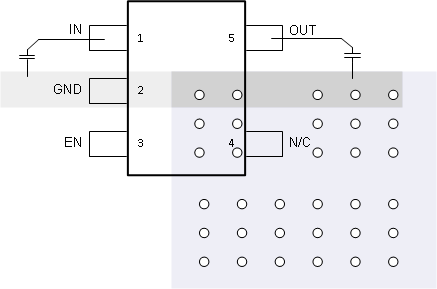SLVSB67C November 2011 – June 2017 TLV70012-Q1 , TLV70018-Q1
PRODUCTION DATA.
10 Layout
10.1 Layout Guidelines
Input and output capacitors should be placed as close to the device pins as possible. To improve ac performance such as PSRR, output noise, and transient response, the board is recommended to be designed with separate ground planes for VIN and VOUT, with the ground plane connected only at the GND pin of the device. In addition, the ground connection for the output capacitor should be connected directly to the GND pin of the device. High ESR capacitors may degrade PSRR performance.
10.2 Layout Example
 Figure 23. TLV700xx Layout Example
Figure 23. TLV700xx Layout Example
10.3 Thermal Considerations
Any tendency to activate the thermal protection circuit indicates excessive power dissipation or an inadequate heatsink. For reliable operation, junction temperature should be limited to 125°C maximum.
To estimate the margin of safety in a complete design (including heatsink), increase the ambient temperature until the thermal protection is triggered; use worst-case loads and signal conditions.
10.4 Power Dissipation
The ability to remove heat from the die is different for each package type, presenting different considerations in the printed circuit board (PCB) layout. The PCB area around the device that is free of other components moves the heat from the device to the ambient air.
Thermal performance data for TLV70018-Q1 and TLV70012-Q1 were gathered using the TLV700 evaluation module (EVM), a 2-layer board with two ounces of copper per side. Corresponding thermal performance data are given in Thermal Information. Note that this board has provision for soldering not only the SOT23-5 package on the bottom layer, but also the SC-70 package on the top layer. Using heavier copper increases the effectiveness in removing heat from the device. The addition of plated through-holes to heat-dissipating layers also improves heatsink effectiveness.
10.4.1 Thermal Calculations
Power dissipation depends on input voltage and load conditions. Power dissipation (PD) is equal to the product of the output current and the voltage drop across the output pass element, as shown in Equation 1.

where
- PD is continuous power dissipation
- IOUT is output current
- VIN is input voltage
- VOUT is output voltage
Since IQ << IOUT, the term IQ × VIN is always ignored.
For a device under operation at a given ambient air temperature (TA), use Equation 2 to calculate the junction temperature (TJ).

where
- ZθJA is the junction-to-ambient air temperature thermal impedance
Use Equation 3 to calculate the rise in junction temperature due to power dissipation.

For a given maximum junction temperature (TJ(MAX), use Equation 4 to calculate the maximum ambient air temperature (TA(MAX) at which the device can operate.
